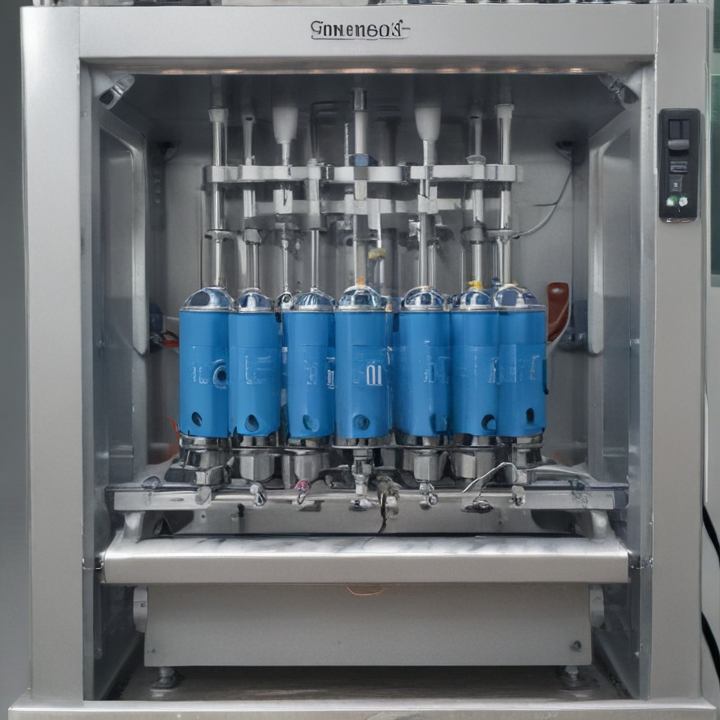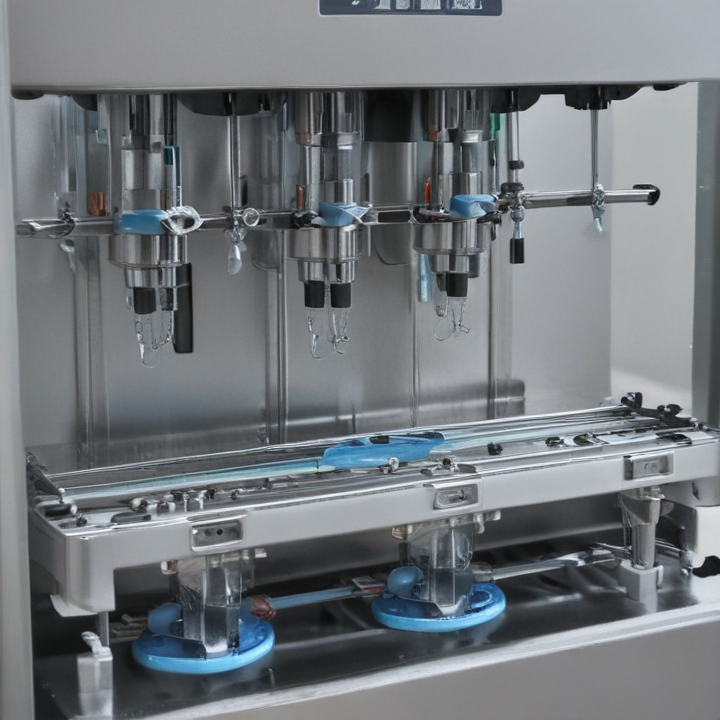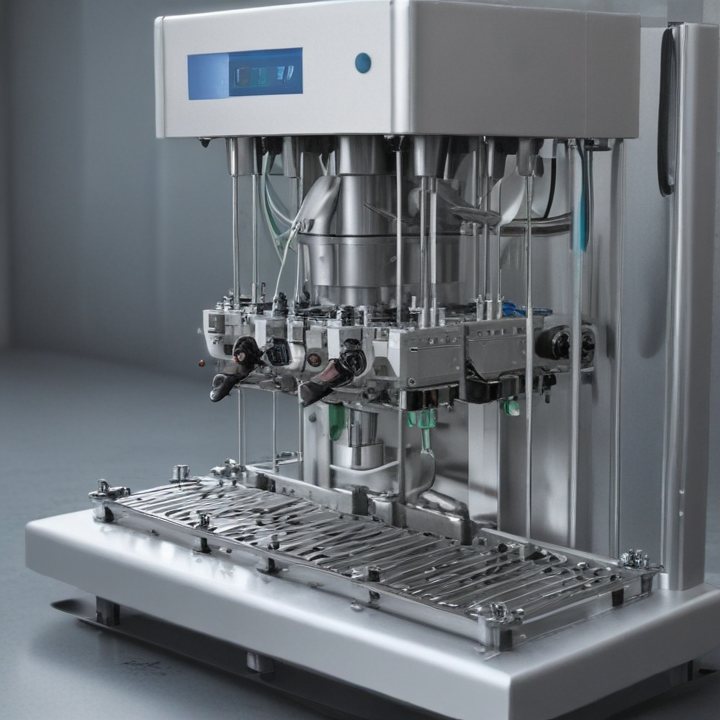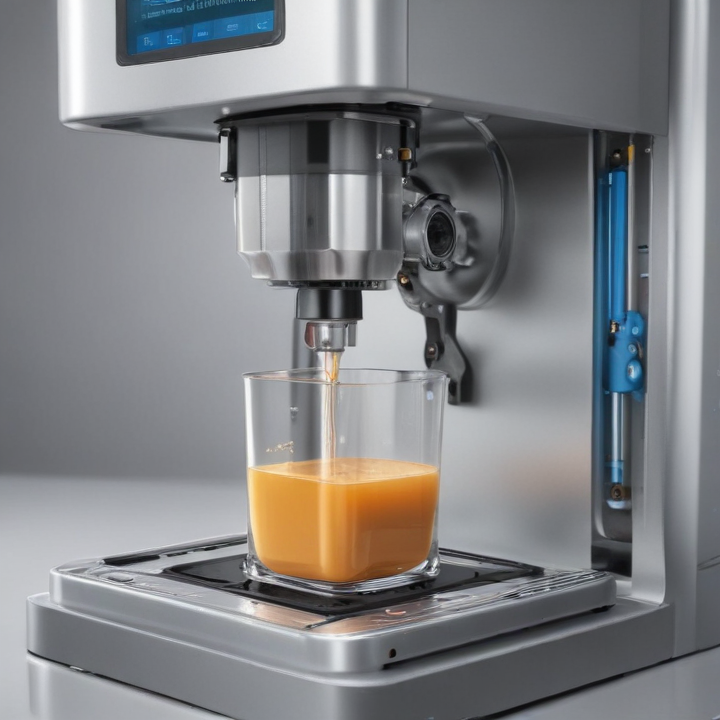List Technical Parameters of “automatic filling machine”
When discussing the technical parameters of an automatic filling machine, a few key elements come into focus. These parameters define the machine’s capabilities and suitability for various applications. Here’s a concise list:
1. Filling Volume Range: Specifies the minimum and maximum volume the machine can fill per container, e.g., 10 ml to 5000 ml.
2. Filling Accuracy: The margin of error in measurement, usually expressed as a percentage, such as ±0.5%.
3. Production Capacity: Measured in units per hour; indicates the volume of production the machine can handle, e.g., 1000-6000 bottles/hour.
4. Type of Filling: Includes gravity filling, piston filling, vacuum filling, and volumetric filling, suitable for different types of products (liquids, pastes, powders).
5. Container Size and Type: Range of container sizes and shapes the machine can handle, e.g., bottles, vials, jars, etc.
6. Material Compatibility: Types of materials the machine can fill, such as liquids, semi-liquids, granules, or powders.
7. Operational Configuration: Single-head or multi-head, indicating how many containers can be filled simultaneously.
8. Control System: Automation level, often involving PLC (Programmable Logic Controller), touchscreen interfaces, and software compatibility.
9. Power Supply: Specifies electrical requirements, e.g., 220V/380V, 50/60 Hz.
10. Air Supply: Compressed air requirements if pneumatic components are used, usually in terms of pressure (psi) and volume (CFM).
11. Construction Material: Usually stainless steel for parts in contact with the product to ensure hygiene and durability.
12. Dimensions and Weight: Physical size and weight of the machine, important for space planning and installation.
13. Optional Features: Extras such as hopper, agitator, CIP (Clean-In-Place), and auto-capping integration.
Understanding these parameters helps in selecting the right machine tailored to specific production needs, ensuring efficiency and cost-effectiveness.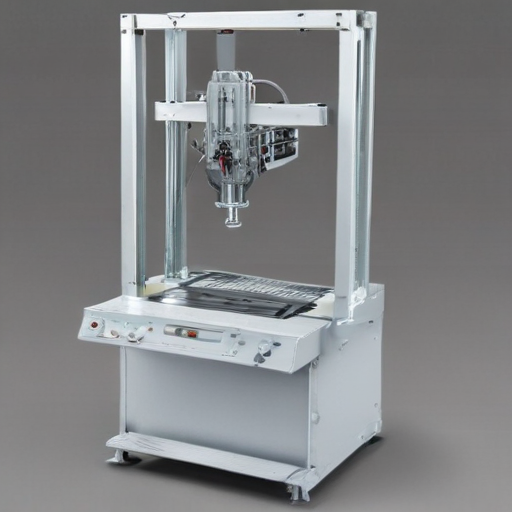
List Product features of “automatic filling machine”
An automatic filling machine offers various features designed to enhance efficiency, precision, and versatility in the filling process. Here are some key features:
1. High Filling Accuracy: Utilizes advanced sensors and precision control systems to ensure accurate filling volumes, reducing wastage and maintaining consistency.
2. Versatile Handling: Capable of filling a wide range of liquids, from low to high viscosity, including water, oils, sauces, and creams.
3. Adjustable Speed: Offers variable speed controls to accommodate different production line speeds and product types, optimizing throughput.
4. User-Friendly Interface: Equipped with intuitive touch-screen controls or HMIs (Human Machine Interfaces) for easy setting adjustments, monitoring, and troubleshooting.
5. Automated Cleaning Systems: Features CIP (Clean-In-Place) or SIP (Sterilize-In-Place) systems that automate the cleaning and sterilization process, ensuring hygiene and compliance with sanitary standards.
6. Multiple Nozzle Configurations: Available with single or multiple nozzles to suit different production requirements, enhancing efficiency and reducing cycle times.
7. Drip-Free Operation: Integrated drip trays and anti-drip mechanisms prevent spillage and maintain clean work environments.
8. Flexible Bottle Handling: Compatible with various container shapes and sizes through adjustable guide rails and conveyor systems.
9. Safety Measures: Equipped with safety guards, emergency stop buttons, and sensors to ensure operator safety and machine protection.
10. Integration Options: Easily integrates with other production line equipment, such as cappers, labelers, and conveyors, for streamlined operations.
11. Data Logging and Reporting: Includes capabilities for data logging, performance tracking, and generating reports, aiding in quality control and regulatory compliance.
12. Automatic Volume Adjustment: Features programmable settings for automatic volume adjustments, allowing quick changeovers and minimizing downtime.
These features collectively make automatic filling machines essential for various industries, offering significant improvements in productivity, accuracy, and operational efficiency.
List Application of “automatic filling machine”
Automatic filling machines are versatile tools employed across various industries to enhance productivity, maintain product consistency, and improve operational efficiency. Below are some key applications of automatic filling machines:
1. Food and Beverage Industry: Used for bottling water, juices, sauces, oils, and alcoholic beverages. They ensure accurate volume filling, reducing waste and maintaining product quality standards.
2. Pharmaceuticals: Crucial for dosing and filling medicinal liquids, syrups, ointments, and creams. They guarantee precision, hygiene, and compliance with stringent regulations.
3. Cosmetics: Employed for filling products like creams, lotions, perfumes, and serums. Automatic filling machines support contamination-free packaging, maintaining the integrity of sensitive formulations.
4. Chemicals: Utilized for filling hazardous or volatile chemicals into containers safely and accurately. These machines often come equipped with safety features to handle corrosive or toxic substances.
5. Household Products: Used for packaging cleaning agents, detergents, and other household chemicals. They ensure consistent dosing and prevent spillage, enhancing user safety.
6. Agriculture: Filling pesticides, fertilizers, and other agrochemicals. Automation helps in managing large volumes efficiently while ensuring precise filling to avoid wastage.
7. Personal Care Products: Facilitates the packaging of shampoos, conditioners, and other personal care items. Ensures uniform filling and reduces manual labor, improving batch consistency.
8. Automotive Industry: Important for the precise filling of oils, lubricants, and other automotive fluids. Enhances operational efficiency and ensures proper product quantity per container.
Each application benefits significantly from the precision, speed, and reliability provided by automatic filling machines, making them indispensable across diverse manufacturing sectors.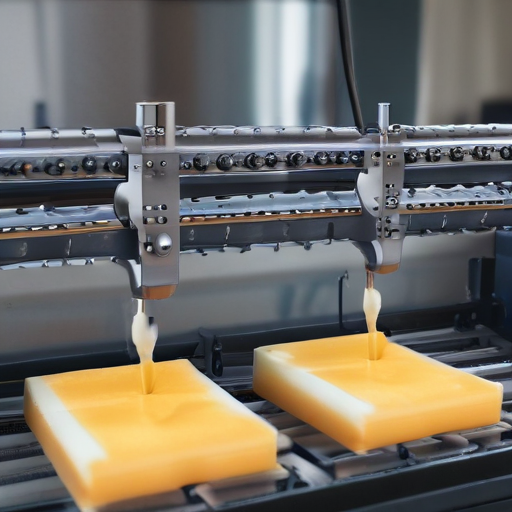
List Various Types of “automatic filling machine”
The term “automatic filling machine” encompasses a variety of equipment used in different industries to automate the process of filling containers with liquids, powders, pastes, or granules. These machines enhance efficiency, accuracy, and productivity. Here are some common types:
1. Liquid Filling Machines: Designed for filling containers with liquids like water, juice, oils, and chemicals.
– *Piston Fillers*: Use a piston to measure and dispense liquids.
– *Gravity Fillers*: Rely on gravity to fill liquids into containers, ideal for thin, free-flowing liquids.
– *Overflow Fillers*: Ensure uniform fill levels, great for transparent containers.
– *Pump Fillers*: Use various pumps (gear, peristaltic, etc.) for accurate dispensing.
2. Powder Filling Machines: Suitable for filling powdered products such as spices, flour, or pharmaceuticals.
– *Auger Fillers*: Use a rotating screw to dispense powders.
– *Vacuum Fillers*: Utilize vacuum to pull powders into the container.
3. Paste Filling Machines: Designed for viscous products like creams, gels, and honey.
– *Piston Paste Fillers*: Incorporate a piston to push out paste precisely.
– *Rotary Fillers*: Ideal for high-volume production with rotary mechanisms.
4. Granule Filling Machines: Best for granular products like grains, seeds, and pellets.
– *Linear Weighers*: Measure and dispense set weight of granules into containers.
– *Volumetric Cup Fillers*: Use cups of fixed volume to dispense evenly.
5. Multi-head Weighing Machines: Often used in food industry; ideal for mixed product types, employing multiple heads to ensure accurate weight and quick fill.
6. Tube Filling Machines: Specially crafted for filling toothpaste, creams, or gels into tubes.
– *Hot-Air Sealing*: Common for plastic tubes.
– *Ultrasonic Sealing*: Used for both plastic and laminate tubes.
7. Aseptic Filling Machines: Used in the pharmaceutical and food industries for sterile filling of products.
8. Bagging Machines: For filling bags with products like coffee, snacks, and pet food.
– *FFS (Form Fill Seal) Machines*: Construct bags from rolls of film before filling.
These machines vary based on the nature of the material being filled, the required production speed, and the specific application requirements.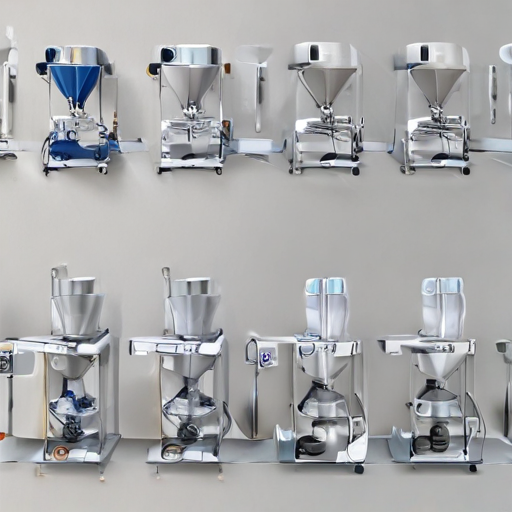
Custom Manufacturing Options for automatic filling machine
When opting for a custom automatic filling machine, various manufacturing options are available to meet specific industry needs. Here’s a concise overview:
1. Filling Mechanism:
– Volumetric Fillers: Ideal for consistent liquid volumes. Variants include piston fillers and gravity fillers.
– Net Weight Fillers: Suited for products sold by weight, ensuring precision.
– Peristaltic Fillers: Perfect for sterile or contaminant-sensitive applications.
2. Type of Liquid:
– Thin Liquids: Pumps designed for low-viscosity liquids.
– Viscous Products: Gear pumps or lobe pumps for thick substances like pastes.
– Foaming Liquids: Anti-foam mechanisms to control bubbles.
3. Container Compatibility:
– Bottles & Jars: Adjustable nozzles to fit various shapes and sizes.
– Bags & Pouches: Custom fillers for flexible packaging.
– Tubes & Vials: Specialized heads for small and precise fills.
4. Automation Level:
– Semi-Automatic: Manual loading with automated filling.
– Fully Automatic: Integrates seamlessly with conveyors and robotic arms for high-efficiency production lines.
5. Material Considerations:
– Stainless Steel: Corrosion-resistant for food, beverages, and pharmaceuticals.
– Plastics & Composites: For non-corrosive and cost-sensitive applications.
6. Integration & Compatibility:
– Existing Production Lines: Customizable to integrate with existing systems like capping machines, labeling machines, and conveyors.
– Software Integration: PLCs and HMI interfaces for seamless control.
7. Safety & Compliance:
– Sanitation Standards: Compliance with FDA, GMP, and other regulatory bodies for food and pharma sectors.
– Explosion-Proof Options: For volatile substances, ensuring safety.
Custom manufacturing solutions for automatic filling machines cater to diverse industrial needs, ensuring precision, efficiency, and compliance.
List Quality Control and The Manufacturing Process of “automatic filling machine”
Quality Control in Automatic Filling Machines:
1. Calibration: Regularly calibrate sensors and filling components to maintain accuracy.
2. Inspection: Daily visual and mechanical inspections to check for wear or damage.
3. Testing: Routine testing with sample products to ensure consistent filling volumes.
4. Cleanliness: Strict hygiene protocols to prevent contamination, especially in food and pharmaceutical sectors.
5. Documentation: Maintain records of maintenance, inspections, and any incidents for traceability.
6. Employee Training: Continuous training programs for operators and maintenance staff.
7. Automated Monitoring: Implement real-time monitoring systems to detect anomalies during the filling process.
8. Standardization: Adherence to industry standards (ISO, GMP) to ensure quality.
Manufacturing Process of Automatic Filling Machines:
1. Design: Engineers create detailed designs based on client specifications and regulatory standards.
2. Material Selection: Choosing appropriate materials for durability, contamination resistance, and compliance with safety standards.
3. Component Manufacturing:
– Machining: Precision machining of parts such as nozzles, pumps, and hoppers.
– Electronic Assembly: Integrating sensors, PLCs (Programmable Logic Controllers), and other electronic components.
4. Assembly:
– Mechanical Assembly: Assembling the frame, conveyor systems, and mechanical parts.
– Integration: Electrical and mechanical systems are integrated for functionality.
5. Software Development: Custom software is developed and installed for machine operation and control.
6. Quality Testing: Rigorous testing to ensure all systems function correctly and meet the specifications.
7. Calibration and Adjustment: Fine-tuning of machine settings to ensure accuracy and efficiency.
8. Certification: Obtaining the necessary certifications (CE, FDA, etc.) to comply with industry regulations.
9. Packaging and Shipping: The machine is securely packaged and shipped to the client.
Regular quality control combined with a meticulous manufacturing process ensures the reliability and efficiency of automatic filling machines.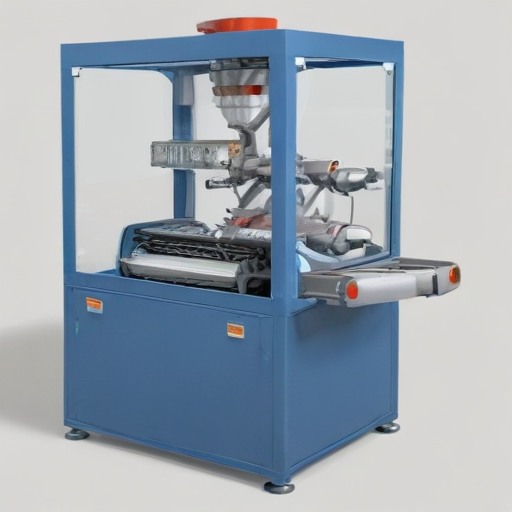
How to use “automatic filling machine”
Using an automatic filling machine efficiently requires understanding its basic components and operation steps. Here’s a concise guide in less than 300 words:
1. Setup: Place the machine on a stable, flat surface near an electrical outlet. Ensure all components like the hopper, conveyor, and filling nozzles are securely attached.
2. Power On: Connect the machine to the power supply and switch it on. Follow the manufacturer’s instructions for initial startup procedures.
3. Adjust Settings: Set the desired filling volume and speed using the control panel. Configure other parameters like the type of liquid, bottle size, and filling precision if needed.
4. Prepare Containers: Clean and arrange the containers (bottles, jars, etc.) on the conveyor belt. Ensure they are compatible with the filling machine’s specifications.
5. Load Product: Fill the hopper or liquid reservoir with the product to be dispensed. Ensure the liquid is free from large particles that could clog the nozzles.
6. Test Run: Before full-scale operation, run a few test cycles to ensure proper dispensing volume and alignment. Adjust settings if necessary.
7. Start Filling: Initiate the automatic filling process by pressing the start button or switch. The conveyor will transport containers under the filling nozzles, dispensing the set volume of liquid into each.
8. Monitor Process: Observe the operation to ensure consistent filling. Be ready to address any jams or discrepancies immediately.
9. End Operation: Once the batch is complete or the hopper is empty, stop the machine via the control panel. Clean the machine according to manufacturer guidelines to maintain hygiene and operational efficiency.
10. Maintenance: Regularly check and maintain the machine, including lubricating moving parts and replacing worn-out components to ensure longevity and reliability.
By following these steps, the automatic filling machine will operate smoothly and efficiently, ensuring accurate and consistent fills.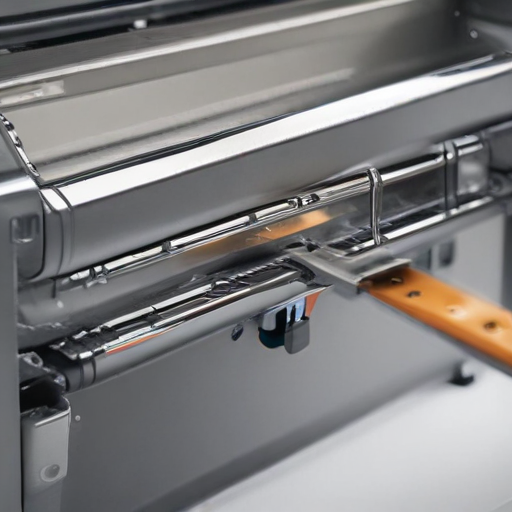
List Properties and Terms of “automatic filling machine”
An automatic filling machine is a device used in various industries to dispense a specified amount of product into containers. They are designed to increase efficiency, accuracy, and consistency in the filling process across different types of liquids, pastes, powders, or granulated products.
### Properties
1. Automation Level: Automatically controls the filling process, reducing manual intervention and labor costs.
2. Accuracy: Ensures precise filling volumes, minimizing product wastage.
3. Speed: Operates at high speeds, significantly increasing production rates.
4. Versatility: Capable of filling various container shapes and sizes.
5. Durability: Made from robust materials to handle prolonged industrial use.
6. Hygiene: Designed to meet sanitary standards, crucial for food, beverages, and pharmaceuticals.
7. Flexibility: Easily adaptable to different products and packaging requirements.
8. Ease of Operation: User-friendly interfaces and controls, often with programmable settings.
9. Maintenance: Requires regular maintenance to ensure optimal performance. Many models are designed for easy cleaning and maintenance.
10. Integration: Can be integrated into larger production and packaging lines.
### Terms
1. Conveyors: Mechanisms that move containers to the filling station.
2. Nozzles: Dispensing ends where products are released into containers.
3. Sensors: Detect the presence and position of containers to ensure accurate filling.
4. Precision Dosing: Technology that ensures the exact amount of product is dispensed.
5. PLC (Programmable Logic Controller): Used for automated control of the machine’s operations.
6. Servo Motors: Provide precise control of filling speed and volume.
7. Variable-Speed Drives: Allow adjustment of the machine’s operating speed.
8. CIP (Clean-in-Place): Automated cleaning systems integrated into the machine.
9. Overflow Fill: Method where excess product overflows back into the reservoir, ensuring uniform fill levels.
10. Gravity Fill: Utilizes gravity to fill containers, suitable for free-flowing liquids.
11. Positive Displacement: Uses pumps to dispense accurate volumes, ideal for viscous liquids.
12. Vacuum Fill: Employs vacuum to pull liquid into containers, useful for frothy and foamy products.
By integrating modern technology and adhering to high manufacturing standards, automatic filling machines enhance production efficiency and product consistency.
List The Evolution history of “automatic filling machine”
The evolution of the automatic filling machine has been marked by numerous technological advancements designed to improve efficiency, accuracy, and reliability in various industries, including food, pharmaceuticals, and consumer goods.
Early 20th Century: Manual Labor and Basic Mechanization
– Initially, filling processes were labor-intensive, relying on manual labor.
– Basic mechanized systems began to take shape, but these early machines were rudimentary and required significant manual oversight.
1940s-1950s: Semi-Automatic Machines
– The mid-20th century saw the introduction of semi-automatic filling machines.
– These machines combined manual and mechanical components, improving speed and reducing human error to some extent.
– Innovations like gravity fillers and volumetric fillers began to emerge.
1960s-1970s: Fully Automatic Systems
– The automation trend accelerated, driven by advancements in electronics and control systems.
– Fully automatic filling machines were developed, incorporating programmable logic controllers (PLCs) for improved precision and efficiency.
– Packaging lines became more integrated, linking filling machines with cappers, labelers, and other equipment.
1980s-1990s: Microprocessors and Improved Accuracy
– The incorporation of microprocessors and enhanced control algorithms allowed for greater accuracy and flexibility.
– Servo motors and other precision components enabled more complex filling applications.
2000s: Digital Transformation and Robotics
– The 21st century ushered in digital transformation, with the introduction of smart sensors and IoT (Internet of Things) connectivity.
– Integration with enterprise resource planning (ERP) systems became common, optimizing production workflows.
– Robotics began to play a significant role, allowing for even greater automation and reducing the need for human intervention.
2010s-Present: Advanced Automation and AI Integration
– Modern automatic filling machines often incorporate AI and machine learning for predictive maintenance and process optimization.
– Increased focus on sustainable practices led to the development of eco-friendly filling technologies.
– Today’s machines are highly versatile, capable of handling a wide range of products and packaging types with minimal changeover times.
In summary, the automatic filling machine has evolved from manual labor-intensive setups to highly sophisticated, fully automated systems that leverage cutting-edge technologies to enhance productivity and precision.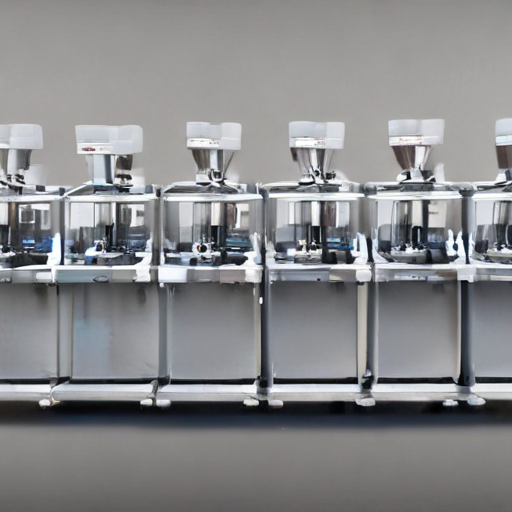
How to Select a Reliable automatic filling machine
Selecting a reliable automatic filling machine involves several key considerations to ensure it meets your production needs efficiently. Here’s a concise guide:
1. Determine Your Requirements:
– Product Type: Identify the viscosity, particulates, and chemical properties of your product.
– Volume: Estimate the production volume and bottle sizes.
2. Machine Types:
– Volumetric Fillers: Ideal for products requiring precise measurements.
– Gravity/Vacuum Fillers: Suitable for thin, free-flowing liquids.
– Piston Fillers: Best for thicker, semi-viscous liquids.
3. Compatibility:
– Ensure the machine materials are compatible with your product to prevent corrosion or contamination.
4. Accuracy and Speed:
– Look for machines that offer high accuracy to minimize waste and meet regulatory standards.
– Check the machine’s filling speed to ensure it aligns with your production rate.
5. Flexibility and Scalability:
– Select a machine that can handle multiple bottle sizes and shapes.
– Consider future growth; a scalable machine can save costs long-term.
6. Ease of Use and Maintenance:
– User-friendly interfaces reduce training time and error.
– Simple maintenance procedures minimize downtime.
7. Reliability and Durability:
– Research machine brands with a reputation for durability and minimal breakdowns.
– Read reviews and ask for references from other users.
8. Technical Support and Warranty:
– Reliable after-sales service is crucial. Ensure the manufacturer offers robust technical support.
– Check the warranty terms to cover potential faults and repairs.
9. Budget:
– Balance the initial cost with the long-term benefits like efficiency, reliability, and lower maintenance costs.
By thoroughly evaluating these factors, you can make an informed decision to select a reliable automatic filling machine that enhances your production efficiency.
List “automatic filling machine” FAQ
FAQs About Automatic Filling Machines
1. What is an automatic filling machine?
– An automatic filling machine is a device used to fill containers, such as bottles or jars, with a specific volume of liquid or semi-liquid product without manual intervention.
2. What types of products can it handle?
– These machines can handle a variety of products including water, juice, oils, pharmaceuticals, cosmetics, and more.
3. What are the benefits of using an automatic filling machine?
– Increased efficiency, consistent fill levels, reduced spillage, higher production rates, and lower labor costs.
4. How does an automatic filling machine work?
– The machine uses different technologies (gravity, piston, vacuum, etc.) to measure and dispense the product into containers meeting precise volume requirements.
5. Are automatic filling machines customizable?
– Yes, they can be tailored to fit different container sizes, shapes, and types of products.
6. What is the maintenance required for an automatic filling machine?
– Regular cleaning, inspection of parts, and lubrication are necessary. Frequency depends on usage and the type of product being filled.
7. How do I choose the right filling machine for my needs?
– Consider factors such as product viscosity, production volume, container type, and the level of automation required.
8. What is the accuracy level of these machines?
– Most automatic filling machines offer high accuracy levels, often within ±1% of the intended fill volume.
9. Are these machines safe to use?
– Yes, they come with safety features and compliance with industry standards to ensure safe operation.
10. How fast can an automatic filling machine operate?
– Speed varies by model and type, but high-speed machines can fill hundreds or even thousands of containers per hour.
11. Can I integrate an automatic filling machine with other packaging systems?
– Absolutely, they can be integrated with conveyors, capping machines, and labeling systems to streamline the entire packaging process.
12. What is the cost of an automatic filling machine?
– Costs vary widely depending on the machine’s specifications, features, and level of customization, ranging from a few thousand to several hundred thousand dollars.
By addressing these common questions, users can get a clearer understanding of how automatic filling machines can fit and benefit their production lines.
Top 10 FAQ with answer about automatic filling machine for Buyer Sourcing from China
Certainly! Here are the top 10 FAQs with concise answers about sourcing automatic filling machines from China:
1. What are the benefits of sourcing automatic filling machines from China?
– China offers competitive pricing, a wide variety of options, and the opportunity to customize machines according to specific requirements. Furthermore, Chinese manufacturers are known for rapid production and delivery.
2. How do I choose the right automatic filling machine manufacturer in China?
– Research extensively on reviews, certifications, and industry experience. It’s advisable to visit their factories, if possible, or ask for virtual tours to check production capabilities and quality control measures.
3. Are Chinese automatic filling machines reliable and of good quality?
– Yes, many Chinese manufacturers produce high-quality machines that meet international standards. Always request certifications like ISO, CE, or FDA and inquire about components’ brands and origins.
4. What are the common payment terms for buying from China?
– Common payment terms include TT (Telegraphic Transfer), LC (Letter of Credit), and Western Union. Typically, manufacturers require a 30% deposit before production and 70% balance before shipment.
5. How long is the lead time for these machines?
– The lead time varies but generally ranges from 30 to 60 days, depending on the complexity of the machine and the manufacturer’s current workload.
6. Can these machines be customized?
– Yes, most manufacturers offer customization options based on your specific needs, including design, capacity, and functionality adjustments.
7. What is the warranty period offered?
– The warranty period ranges from 12 to 24 months. Confirm details about what is covered, such as parts, labor, and any instances of machine breakdown.
8. How about after-sales support and spare parts?
– Chinese manufacturers often provide after-sales support, including online troubleshooting, sending technicians, and supplying spare parts. Clarify the support terms beforehand.
9. Is it safe to import these machines amidst International Trade Regulations?
– Yes, with proper documentation, compliance with international trade regulations, and working with reputable logistics companies, importing these machines is safe.
10. What shipping methods are recommended?
– Sea freight is the most cost-effective for large and heavy machinery. For smaller, urgent orders, air freight may be more suitable. Discuss shipping terms (FOB, CIF) with your supplier.
These concise answers should equip buyers with the essential information to make informed decisions when sourcing automatic filling machines from China.

